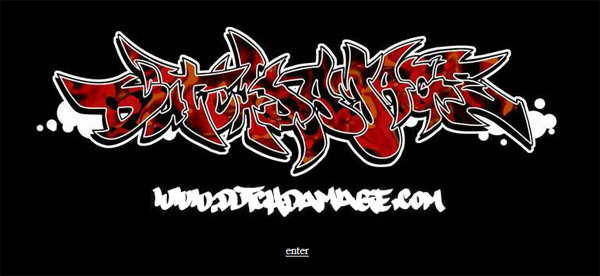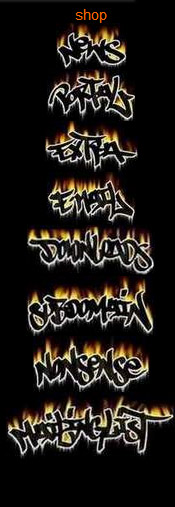Exit Through the Webshop
The following is an interview with the founder of dutchdamage, Matthijs van der Meulen, currently head of the digital media department at the Stedelijk Museum Amsterdam.

Q: How did Dutchdamage come into being?
A: In 1996 I started taking pictures with an analog compact camera of my own graffiti work, but I also photographed as much (local) graffiti as possible. My collection of flix quickly grew out of control, at the point when there were over 7000 prints arranged in stacks in my room, awaiting to be scanned. Around 1997, Alkmaar had the first experiments with internet through cable connections, which paved the way for the idea of a website that could serve as a place to show and share these pictures on the web. This started with a simple and standard homestead crew-website that represented the local graffiti scene in Alkmaar, consisting of roughly 10 writers at that time. The social interaction took place mostly offline, although the guestbook was also used to socialize. Here, most members used their graffiti handles to communicate semi-anonymously. Because Google did not exist, I emailed and linked to the ten (international) graffiti websites that were out there, such as artcrimes, graffiti.org, etc. We were linked back to by more and more sites and the amount of daily hits kept growing.
 The storage capacity of the homestead site was limited to around 200 MB, which meant 20 pictures for every member. As the site gained popularity, people started sending me pictures by regular mail to scan and put up online. With the collection growing fast, and around a thousand hits a day, we needed to scale up. Through local connections I met a programmer, daantje.nl who was learning php and who needed a project to experiment with dynamic databases that could serve him as a showcase. He was able to arrange sponsored hosting, which made it all the more affordable. The mailinglist kept growing and we added loads of new functionalities to the homepage that soon became a portal for all things graffiti; an engine for searching the database of pictures, free subdomains for users, a chatbox, etc. In 2001 we were getting around ten thousand visitors every day.
The storage capacity of the homestead site was limited to around 200 MB, which meant 20 pictures for every member. As the site gained popularity, people started sending me pictures by regular mail to scan and put up online. With the collection growing fast, and around a thousand hits a day, we needed to scale up. Through local connections I met a programmer, daantje.nl who was learning php and who needed a project to experiment with dynamic databases that could serve him as a showcase. He was able to arrange sponsored hosting, which made it all the more affordable. The mailinglist kept growing and we added loads of new functionalities to the homepage that soon became a portal for all things graffiti; an engine for searching the database of pictures, free subdomains for users, a chatbox, etc. In 2001 we were getting around ten thousand visitors every day.
Since 1998 I had been working at Henxs, the Waterlooplein marketstand that sold Belton spraycans. When talking about Dutchdamage we thought we could try to set up an online shop as an extra service and a way to make money out of it. The onlineshop was a big success, shipping graffiti stuff to most of Europe. In 2004 we had to move the site to Joomla. Daantje was too busy working on other jobs and in order to keep the business running smoothly, Dutchdamage became a part of the Henxs.com domain.
Q: Along came social media. How did this affect Dutchdamage?
A: Obviously, the biggest change for us came with Flickr. The amount of visitors dropped as every one could now host their own photo collections without any knowledge of html or php. Activity remained but the site had lost its unique feature. Before, many photos were sent to me by post. I made the selection; what to scan and put online. We didn’t write down credits for the photos since most material was still considered illegal. We started uploading our own collection to Flickr as well. This opened up the material to a new crowd and made it a lot more accessible to people from outside the graffiti scene. Many discussions about graffiti, photography and related stuff moved to these SNS platforms where people could write comments everywhere, and keep track of these discussions themselves. Moderating comments was one of the major hassles when running Dutchdamage. Especially with privacy sensitive material, such as illegal graffiti, this can get quite tricky.
Q: What are the major influences the web has had on graffiti?
 A: I think the web has changed graffiti as much as it has changed everything else. From the start of Dutchdamage it was clear that it had its pro’s and con’s, and the participants in the scene were somewhat divided on this. On the one hand, the easy ways of getting in contact with graffiti writers worldwide was an obvious pro. On the other hand, privacy and anonymity became an issue. In the beginning most writers used their graffiti handles along with their crew affiliations linked to their email. After a year or two people became more cautious, as law officials were also aware of the site and reading the discussion boards. Luckily, there was so much BS circulating through these discussion threads, it was impossible to monitor for any local law enforcement agency.
A: I think the web has changed graffiti as much as it has changed everything else. From the start of Dutchdamage it was clear that it had its pro’s and con’s, and the participants in the scene were somewhat divided on this. On the one hand, the easy ways of getting in contact with graffiti writers worldwide was an obvious pro. On the other hand, privacy and anonymity became an issue. In the beginning most writers used their graffiti handles along with their crew affiliations linked to their email. After a year or two people became more cautious, as law officials were also aware of the site and reading the discussion boards. Luckily, there was so much BS circulating through these discussion threads, it was impossible to monitor for any local law enforcement agency.
Today, it seems legal graffiti is gaining terrain, as street/urban art has become more accepted as an art practice. Considering graffiti styles, the local flavours of the nineties have largely made place for an eclectic international style. It’s still possible to recognise certain styles as typically Dutch, or say Polish, this no longer implies the nationality of the writers. For the most, the web has made graffiti even more publicly visible as it ever was. This meant a wider audience and more contact between writers. But a lot of the old DIY romance is gone. How to make the right fatcap, how to make the best tagging-ink by mixing leather dye and break fluid, were popular topics on dutchdamage, now you order all this stuff online without realizing how it got there in the first place. Presently, the social interactions amongst new generations of graffiti writers seem to be moving back to local and legal scenes and the romance of the late nineties has dissipated, as hardcore graffiti writers move from SNS platforms, back to the underground of the dark web and the night-time streets that are belong to them.